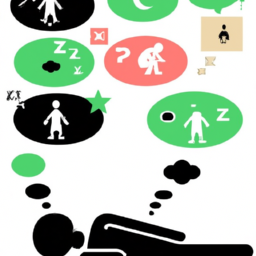As someone who has struggled with anxiety-filled dreams, I know the frustration of waking up tired and anxious. It’s not just the physical exhaustion these dreams cause, but also the emotional burden they carry.
That’s why I’ve put together this guide on how to stop anxious dreams, based on research and personal experience.
Anxious dreams can stem from a variety of causes, such as stress, anxiety, trauma, or even an unhealthy sleep routine. The good news is that there are many strategies and techniques that can help reduce the frequency and intensity of these dreams.
By incorporating relaxation techniques, creating a relaxing sleep environment, and managing our thoughts and emotions during these dreams, we can take steps towards a more peaceful night’s rest.
So, let’s dive into some effective ways to stop anxious dreams and get the restful sleep we deserve.
Key Takeaways
- Relaxation techniques such as deep breathing, progressive muscle relaxation, and mindfulness can help reduce anxious dreams.
- Creating a relaxing sleep environment with comfortable bedding and pillows, a cool and dark bedroom, and soundproofing can also be helpful.
- Identifying the root cause of anxious dreams, such as psychological factors or medication use, and addressing those underlying issues can lead to fewer anxious dreams.
- Natural remedies and supplements like herbal teas, aromatherapy, and homeopathic remedies can also be used in conjunction with other strategies to reduce anxious dreams, but should be used with caution and under the guidance of a qualified practitioner.
Understanding the Causes of Anxious Dreams
You’re probably wondering why you keep having those anxious dreams and what’s causing them to occur. Well, there are various reasons why you might be experiencing anxiety-induced dreams.
One of the main causes of anxious dreams is psychological factors such as stress, anxiety, depression, and trauma. When our minds are preoccupied with negative thoughts and emotions, it can affect our sleep and lead to nightmares and disturbing dreams.
Moreover, certain medications, substance abuse, and withdrawal can also contribute to anxious dreams. It’s essential to identify the root cause and address the underlying issue to prevent recurring nightmares.
In the following section, we’ll explore some techniques for managing anxiety and practicing relaxation to promote restful sleep.
Practicing Relaxation Techniques
I find that practicing relaxation techniques has been helpful for me in reducing the frequency and intensity of my anxious dreams. Some techniques that have worked for me include deep breathing exercises, progressive muscle relaxation, and meditation/mindfulness.
These techniques have been shown to reduce stress and anxiety levels, leading to a more relaxed state of mind before bed.
Deep Breathing Exercises
To calm your racing mind before bed, take a few moments to practice some simple deep breathing exercises that will feel like a cool breeze sweeping through your body. Breathing techniques are an effective way to relax your mind and body, allowing you to fall asleep more easily and avoid anxious dreams. By focusing on your breath, you can create a mind-body connection that promotes relaxation and reduces stress.
One simple breathing exercise that you can try is called the 4-7-8 technique. Inhale deeply through your nose for a count of four, hold your breath for a count of seven, and exhale slowly through your mouth for a count of eight. Repeat this cycle four times or until you feel a sense of calm. The table below illustrates the steps of this technique:
| Step | Action | Duration |
|---|---|---|
| 1 | Inhale | 4 |
| 2 | Hold | 7 |
| 3 | Exhale | 8 |
| 4 | Repeat | 4x |
Incorporating deep breathing exercises like the 4-7-8 technique into your bedtime routine can help reduce the likelihood of anxious dreams. As you become more comfortable with this technique, you may find that you are able to fall asleep more easily and wake up feeling more refreshed. In addition to deep breathing, another effective relaxation technique is progressive muscle relaxation.
Progressive Muscle Relaxation
Incorporating progressive muscle relaxation into your nighttime routine can be an effective way to release tension and promote relaxation throughout your body. This technique involves tensing and then relaxing each muscle group, starting from your toes and moving up to your head. By focusing on the sensations of tension and relaxation, you can increase your awareness of bodily sensations and reduce physical and mental stress.
Here are some benefits of progressive muscle relaxation and steps to practice it effectively:
-
Benefits:
-
Reduces muscle tension and pain
-
Improves sleep quality
-
Lowers anxiety and stress levels
-
Steps to practice:
- Find a quiet and comfortable place to lie down or sit
- Close your eyes and take a few deep breaths
- Focus on tensing and then relaxing each muscle group for about five seconds each
- Move slowly and methodically from your toes to the top of your head
- Repeat the process for at least 10-15 minutes
By incorporating progressive muscle relaxation into your nightly routine, you can reduce the frequency and intensity of anxious dreams. Now, let’s move on to the next technique: meditation and mindfulness.
Meditation and Mindfulness
You can benefit from practicing meditation and mindfulness to improve your overall mental health and well-being. Mindfulness is about being present and fully engaged in the moment, rather than being lost in thoughts or worries about the past or future.
You can start by practicing mindful breathing, which involves focusing your attention on your breath and noticing your thoughts without judgment. Guided visualization is another helpful technique that can promote relaxation and reduce anxiety. This involves imagining a peaceful scene or situation, such as a beach or a forest, and allowing yourself to fully experience the sights, sounds, and sensations of that environment.
Incorporating meditation and mindfulness into your daily routine can help you manage anxious dreams and promote better sleep. By practicing these techniques regularly, you can train your mind to focus on the present moment and let go of worries and stressors that might be keeping you up at night.
In the next section, we’ll explore how to create a relaxing sleep environment to further enhance your sleep quality.
Creating a Relaxing Sleep Environment
As someone who struggles with anxious dreams, I know the importance of creating a relaxing sleep environment.
Three key factors that have helped me are comfortable bedding and pillows, temperature control, and reducing noise and light.
Investing in a comfortable mattress and pillows that support your body can greatly improve your sleep quality.
Keeping your bedroom cool, dark, and quiet can also help you fall asleep faster and stay asleep longer.
Comfortable Bedding and Pillows
Imagine sinking into a cloud of softness with cozy bedding and pillows that make you feel like you’re sleeping on a fluffy marshmallow. It’s essential to choose bedding and pillows that suit your preferences to ensure a comfortable sleep.
Bedding preferences vary from person to person, and it’s crucial to choose the right one for you. If you prefer a warm and cozy bed, flannel sheets may work best for you. If you’re a hot sleeper, cotton sheets may be a better option.
Pillow selection is also crucial in creating a comfortable sleep environment. The right pillow can help support your neck and reduce discomfort, making it easier to fall asleep and stay asleep. If you sleep on your back, a medium or thin pillow may work best. If you sleep on your side, a firmer pillow will provide better support.
As you choose your bedding and pillows, keep in mind that the goal is to create a comfortable, relaxing environment that promotes restful sleep.
Next, we’ll discuss the importance of temperature control in achieving a good night’s sleep.
Temperature Control
Maintaining a comfortable temperature in your sleep environment is crucial for achieving a restful night’s sleep. The ideal temperature for promoting deep sleep is between 60-67 degrees Fahrenheit, but each person’s preference may differ slightly. Therefore, it’s important to find the right thermostat settings that work best for you.
In addition to setting the thermostat, there are also cooling techniques that can be used to create a comfortable sleep environment. For example, using a fan or opening a window can help circulate cool air throughout the room. Additionally, wearing breathable pajamas and using lightweight bedding can also help regulate body temperature.
By maintaining a comfortable temperature in your sleep environment, you can reduce the likelihood of experiencing anxious dreams and enjoy a more peaceful night’s sleep.
Creating a comfortable sleep environment goes beyond just temperature. In the next section, we’ll explore ways to reduce noise and light for an even more restful night’s sleep.
Reducing Noise and Light
To truly create a sanctuary for your slumber, it’s important to limit the intrusion of noise and light into your sleep environment. Soundproofing tips are an effective way to reduce noise pollution. One way is to install acoustic panels on the walls and ceiling of your room. These panels absorb sound waves and reduce echoes, resulting in a more peaceful sleeping environment. Another option is to use white noise machines or apps that play calming sounds, such as raindrops or ocean waves, to drown out external noises.
Light blocking curtains are also essential in reducing light pollution. These curtains are designed to block out sunlight and streetlights, creating a dark environment that promotes restful sleep. A 2 column and 4 row table can help you compare different types of curtains and their light blocking capabilities. For example, blackout curtains block out 99% of light, while room darkening curtains only block out 80-90%. By choosing the right curtains, you can minimize the disruption of light and create a more conducive environment for sleep.
By creating a sleep environment that is quiet and dark, you can greatly reduce the likelihood of anxious dreams. However, there’s more to achieving restful sleep than just controlling your environment. Developing a consistent sleep routine is also crucial for promoting healthy sleep habits.
Developing a Consistent Sleep Routine
Establishing a regular sleep schedule can greatly reduce the occurrence of anxious dreams. A consistent sleep routine benefits the body in many ways, including improving the quality of sleep, regulating the body’s circadian rhythm, and reducing stress and anxiety.
To establish a consistent sleep routine, one should aim to go to bed and wake up at the same time every day, even on weekends. This helps the body get into a natural rhythm, making it easier to fall asleep and stay asleep throughout the night.
In addition to going to bed and waking up at the same time, other tips for establishing a consistent sleep routine include avoiding caffeine and alcohol before bed, creating a relaxing bedtime ritual, and avoiding stimulating activities such as using electronic devices or watching TV before bed.
By incorporating these tips into your daily routine, you can reduce the occurrence of anxious dreams and improve the overall quality of your sleep. With a consistent sleep routine in place, you can move on to managing your thoughts and emotions during anxious dreams, which we’ll discuss in the next section.
Managing Thoughts and Emotions During Anxious Dreams
When you experience intense emotions during a dream, it can be difficult to manage them in a healthy way. However, there are several visualization techniques that can be helpful in reducing the intensity of these emotions.
One such technique is imagining the dream scene in a different, more positive way. For example, if you’re being chased in your dream, try visualizing yourself turning around and confronting the threat with confidence. Another technique is to focus on your breathing and imagine the emotions leaving your body as you exhale.
Additionally, cognitive behavioral therapy (CBT) can be helpful in managing anxious thoughts and emotions during dreams. CBT involves identifying negative thought patterns and learning how to replace them with more positive, realistic thoughts. This can be done through techniques such as reframing negative thoughts and practicing relaxation exercises.
By using visualization techniques and CBT, it’s possible to reduce the intensity of anxious dreams and improve your overall sleep quality. When it comes to managing anxious dreams, visualization techniques and CBT can be helpful tools. However, it can also be beneficial to engage in journaling and self-reflection.
By writing down your dreams and reflecting on them, you may be able to identify patterns and triggers that contribute to your anxiety. This can help you develop a better understanding of your emotions and provide insight into potential solutions.
Journaling and Self-Reflection
As someone who struggles with anxious dreams, I’ve found that journaling and self-reflection can be incredibly helpful tools.
By identifying triggers and patterns in my dreams, I’m able to better understand what may be causing my anxiety.
Expressing my emotions and feelings through writing allows me to process and release them, leading to a sense of relief and calm.
Through consistent journaling, I’ve also been able to build self-awareness and emotional intelligence, which has helped me manage my anxiety not only in my dreams but in my daily life as well.
Identifying Triggers and Patterns
Recognizing your triggers and patterns can help you take control of your anxious dreams and get a better night’s sleep. By identifying the things that trigger your anxiety, you can take steps to avoid or minimize them, reducing the likelihood of experiencing anxious dreams. Here are five things to keep in mind when identifying your triggers and patterns:
-
Reflect on the events and situations that preceded your anxious dreams. This can help you pinpoint the specific triggers that led to your anxiety.
-
Pay attention to your physical and emotional states when you have an anxious dream. This can help you identify patterns in your thoughts, feelings, and behaviors that contribute to anxiety.
-
Seek support from others, such as a therapist or trusted friend. They can offer an outside perspective and help you identify triggers and patterns that you may not have noticed on your own.
-
Keep a dream journal. This can help you track your dreams over time and identify recurring themes or patterns that may be contributing to your anxiety.
-
Practice mindfulness and relaxation techniques, such as meditation or deep breathing. These techniques can help you stay calm and centered, even in the face of triggers that might otherwise cause anxiety.
By recognizing your triggers and patterns, you can take steps to address them and reduce your anxiety. In the next section, we’ll explore how expressing your emotions and feelings can further help you manage anxious dreams.
Expressing Emotions and Feelings
To better manage your anxiety and improve your sleep, it’s important to express your emotions and feelings through creative outlets like journaling, drawing, or talking with a trusted friend. Expressive writing, a form of journaling that involves writing about your thoughts and feelings, has been shown to reduce anxiety and improve sleep quality. This type of writing allows you to process and release negative emotions, ultimately leading to a more relaxed state of mind.
Talking therapy, such as cognitive-behavioral therapy (CBT), can also help you identify and address the underlying causes of your anxiety. This type of therapy involves talking with a trained professional who can guide you through the process of changing negative thought patterns and behaviors. By learning effective coping strategies and building self-awareness and emotional intelligence, you can take steps towards reducing anxious dreams and improving your overall well-being.
Building Self-Awareness and Emotional Intelligence
After learning about the importance of expressing emotions and feelings, I realized the next step in managing my anxious dreams is to build self-awareness and emotional intelligence. Emotional regulation is key in managing anxiety, and understanding the mind-body connection can help me identify triggers and manage my emotions before they spiral into anxious thoughts.
To build self-awareness, I need to slow down and take a closer look at my thoughts and emotions. I can do this by practicing mindfulness and meditation, which can help me tune in to my body and emotions. Additionally, keeping a journal can help me identify patterns and triggers in my thoughts and emotions. By understanding these patterns, I can take steps to manage my emotions before they become overwhelming.
- Practice mindfulness and meditation
- Keep a journal to identify patterns and triggers
- Use this self-awareness to manage emotions before they spiral out of control
By building self-awareness and emotional intelligence, I can take control of my anxious thoughts and dreams. However, managing anxiety is an ongoing process, and I need to incorporate self-care and stress management techniques to maintain my progress.
Practicing Self-Care and Stress Management
Taking care of yourself and managing stress can make a significant difference when it comes to reducing anxious dreams. Incorporating self-care practices into your daily routine can help you relax, unwind, and improve your overall mental health.
Some self-care practices that you may want to consider include exercise, meditation, or spending time doing activities that you enjoy. Engaging in regular exercise is a great way to manage stress and improve your mood. Exercise releases endorphins that can help you feel more relaxed and reduce anxiety.
Practicing mindfulness meditation or deep breathing exercises can also help you cultivate a sense of calm and reduce stress levels. Additionally, engaging in activities that you enjoy, such as reading, listening to music, or spending time in nature, can help you relax and improve your overall well-being.
By prioritizing self-care practices and stress management techniques, you can take an important step towards reducing anxious dreams and feeling more at ease in your daily life.
Incorporating natural remedies and supplements can also help you reduce anxious dreams. While some natural remedies may not have enough scientific evidence to prove their effectiveness, others have been shown to be helpful in reducing anxiety and promoting relaxation. Next, we’ll explore some natural remedies and supplements that you may want to consider trying to help alleviate anxious dreams.
Trying Natural Remedies and Supplements
I’ve found that trying natural remedies and supplements can be an effective way to manage my stress and anxiety. This, in turn, helps me sleep better and prevents anxious dreams.
Some of my favorite natural remedies include herbal teas and supplements, such as chamomile tea and valerian root capsules. I also enjoy using aromatherapy and essential oils, like lavender and peppermint, to create a calming atmosphere before bed.
Lastly, I’ve had success with homeopathic remedies, such as Bach flower remedies, which are designed to address specific emotional states.
Herbal Teas and Supplements
Sipping on a warm cup of chamomile tea before bed can help calm the mind and promote more peaceful sleep, like a soothing lullaby in a mug. Chamomile is a natural sedative that has been used for centuries to treat anxiety and insomnia. Valerian root is another herbal supplement that can help reduce anxiety and improve sleep quality. However, it’s important to note that herbal supplements can have potential side effects and should be used with caution.
To fully enjoy the benefits of chamomile and other herbal supplements, consider these tips:
- Use high-quality, organic herbs to ensure purity and potency.
- Brew tea for at least 5-10 minutes to release the full flavor and benefits.
- Add honey or lemon to enhance the taste and soothe the throat.
- Consult a healthcare professional before taking any herbal supplements, especially if you’re pregnant, breastfeeding, or taking medication.
Transitioning into the subsequent section about aromatherapy and essential oils, it’s important to explore other natural remedies that can promote peaceful sleep and reduce anxious dreams.
Aromatherapy and Essential Oils
Indulging in the soothing scents of essential oils can transport you to a world of calmness and relaxation, making it easier to peacefully drift off to sleep.
Aromatherapy benefits are well-documented, with essential oils possessing potent properties that promote relaxation and calmness. Essential oil blends, such as lavender, chamomile, and bergamot, have been shown to reduce anxiety levels, improve sleep quality, and reduce the frequency of anxious dreams.
Essential oils can be diffused in the air or applied topically to the skin, depending on the intended use. For example, diffusing lavender oil in the bedroom can create a calming environment that promotes relaxation and better sleep quality. Alternatively, applying a drop of bergamot oil to the temples can help ease anxiety and reduce the likelihood of experiencing anxious dreams.
Incorporating essential oils into your bedtime routine can be a powerful tool in managing anxious dreams and promoting restful sleep. As effective as aromatherapy is, it may not work for everyone. If you’re looking for alternative treatments, homeopathic remedies may be the next step.
Homeopathic Remedies
You can try using homeopathic remedies to promote restful sleep and manage any anxiety or stress that may be causing disrupted sleep. Homeopathy is a natural form of medicine that involves using highly diluted substances to stimulate the body’s natural healing process. The benefits of homeopathy for anxiety and sleep disorders have been well documented in research studies.
Some common homeopathic remedies for anxiety and sleep include Ignatia, Arsenicum, and Gelsemium. When using homeopathic remedies, it’s important to follow the recommended dosage for each remedy. Dosage will depend on the specific remedy being used and the severity of the symptoms.
It’s also important to consult with a qualified homeopathic practitioner to ensure that the remedies are being used correctly and safely. With the assistance of homeopathic remedies, you can experience a more restful sleep and reduced anxiety levels. If, however, your symptoms persist, it may be time to seek professional help.
Seeking Professional Help
Finding relief from anxious dreams can be difficult, but one option to consider is seeking professional help. Counseling options are available for those who want to address the root causes of their anxiety and improve their mental health.
Finding a therapist can be a daunting task, but there are several steps that can be taken to ensure that the right match is made. First, consider the type of therapy that may be best suited for your needs. Cognitive-behavioral therapy (CBT) is a common approach that focuses on changing negative thought patterns and behaviors. Eye movement desensitization and reprocessing (EMDR) is another effective therapy for those who have experienced trauma.
It is also important to find a therapist who is licensed and experienced in treating anxiety-related disorders. Finally, consider the cost and location of the therapy sessions to ensure that they are accessible and affordable.
Seeking professional help can be a valuable step in managing anxious dreams and improving overall mental health. In addition to therapy, there are other resources available for those struggling with anxiety. Support groups, online forums, and self-help books can provide additional guidance and comfort.
It is important to remember that seeking help is a sign of strength, and there’s no shame in asking for assistance when it’s needed. With the right tools and support, it’s possible to overcome anxious dreams and live a happier, more fulfilling life.
Frequently Asked Questions
Can anxious dreams be a sign of a more serious mental health issue?
Anxious dreams can be a sign of a more serious mental health issue. Possible causes include anxiety disorders, PTSD, and depression. It’s important to seek professional help if you experience persistent anxious dreams or other mental health symptoms.
Is it normal to have anxious dreams even if you don’t have anxiety during the day?
Yes, it is normal to have anxious dreams even if you don’t have anxiety during the day. Dream journaling and cognitive behavioral therapy can help identify triggers and develop coping strategies to reduce the frequency and intensity of anxious dreams.
Can certain foods or drinks affect the likelihood of having anxious dreams?
Food influences the quality of our sleep, including the likelihood of anxious dreams. Maintaining good sleep hygiene, such as avoiding caffeine and heavy meals before bedtime, can improve sleep and reduce the chance of anxious dreams.
Are there any specific breathing techniques that can help reduce anxious dreams?
Breathing exercises and mindfulness meditation have been shown to reduce overall anxiety and stress levels, which can lead to fewer anxious dreams. Incorporating these practices into a daily routine can promote relaxation and restful sleep.
Can listening to music before bed help prevent anxious dreams?
Music therapy is a relaxation technique that can help prevent anxious dreams. Listening to calming music before bed can soothe your mind and body, promoting a peaceful sleep. Give it a try!
Conclusion
In conclusion, anxious dreams can be a frustrating and exhausting experience, but there are numerous techniques and strategies that can help alleviate their frequency and intensity.
By understanding the root causes of our anxious dreams, practicing relaxation techniques, creating a soothing sleep environment, and developing a consistent sleep routine, we can empower ourselves to take control of our sleep and wake up feeling refreshed and rejuvenated.
Managing thoughts and emotions during anxious dreams, journaling and self-reflecting, practicing self-care and stress management, trying natural remedies and supplements, and seeking professional help if necessary, are also effective ways to deal with this common sleep problem.
Remember, there is no one-size-fits-all solution to anxious dreams, but by experimenting with different methods and finding what works best for you, you can overcome this issue and enjoy a more peaceful and restful night’s sleep.
So take a deep breath, relax, and don’t let anxious dreams keep you up at night. Sweet dreams!









